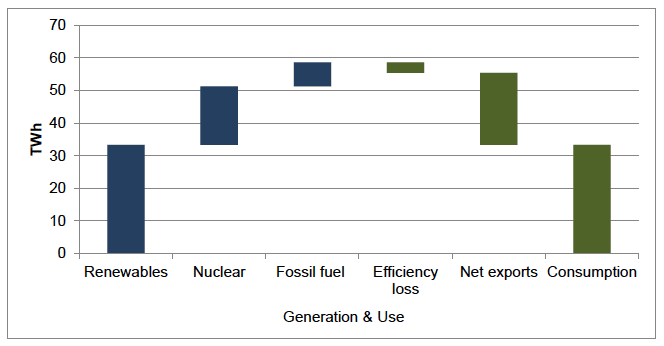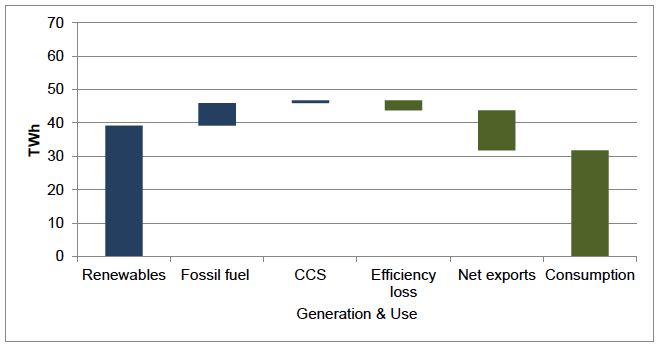Climate Change Plan: third report on proposals and policies 2018-2032 – technical annex
This annex provides an overview of the analysis underpinning the Climate Change Plan
Electricity sector
Sector Overview
The base year capacity of the generation technologies, broadly categorised as fossil fuel, nuclear and renewable, are calibrated to the actual installed capacity in Scotland in 2016. The future installed capacity of these technologies is estimated according to the current planned or under construction generation projects, and constraints on deployment potential.
In order to check that the generation mix proposed by the selected TIMES scenario is feasible, it was stress tested using the Scottish Electricity Dispatch Model ( SEDM). This confirmed that the proposed capacities were technically feasible, alongside use of interconnection with the integrated GB electricity network, relying on existing and proposed network projects.
Data inputs:
Since publication of the draft Plan, we have updated historic generation, capacity and load factors, based on BEIS' Energy Trends December 2016, DUKES 2016, BEIS Renewable electricity capacity and generation (2017), BEIS Regional Statistics - 2003 - 2015: Standard Load Factors, the Renewable Energy Planning Database (2017), and from an updated version of UK TIMES.
Other sources used in the sector include the Scottish Government's Energy in Scotland publication and the SEDM, as well as data inherited from UK TIMES.
Floating wind generation is also now available to the model, based on Scottish-specific project data.
Additional constraints since the Draft Plan:
A series of further modelling constraints have also been applied to the Electricity sector in response to feedback on the draft Climate Change Plan and Energy Strategy, as follows:
- We have constrained offshore wind electricity generation capacity between 2020 and 2025, reflecting installed and planned capacity
- We have updated the constraint on exports/imports of electricity to ensure the system maintains sufficient capacity to continue exporting to the rest of the UK, and that Scottish climate targets are not met by exporting emissions to other parts of the GB system
- The introduction of Carbon Capture and Storage ( CCS) for electricity generation has been delayed to after 2030, and the use of biomethane and other biomass in electricity generation processes fitted with CCS has been constrained to zero, eliminating the model's ability to generate negative emissions in the electricity sector
- We have also maintained capacity for a natural gas electricity generation plant at a minimum of around 1 GW for the duration of the Plan
Results:
The figure below presents projected electricity generation and consumption in 2020 in the Climate Change Plan. Renewables are the largest source of electricity, amounting to around 33 TWh, followed by nuclear and fossil fuel generation. After accounting for a small efficiency loss and net exports, electricity consumption is nearly 33 TWh. This represents an increase over actual electricity consumed in 2015 (30.9 TWh [5] ),
Figure 9: Electricity Generation and Use in 2020 (TIMES model results), (Electricity storage technologies are not in the above as they are deployed further down the supply chain)

The results are similar in 2032. Overall electricity generated is lower than 2020, with around 39 TWh of renewable electricity generated, followed by nearly 7 TWh of fossil fuels. The system remains a net exporter in that year with net exports around 12 TWh. In 2032, consumption of electricity is expected to be higher than what it was in 2015, at around
32 TWh.
Figure 10: Electricity Generation and Use in 2032 (TIMES model results) (Electricity storage technologies are not in the above as they are deployed further down the supply chain)

Emissions in the electricity sector are projected to fall by 28% over the lifetime of the plan. This is driven by the switch away from natural gas and coal towards onshore wind (which becomes the main source of electricity generation in Scotland), and offshore wind (which sees the largest increase in electricity generated between the two periods).
However, it should be noted that Scottish TIMES does not model electricity generation within the rest of GB system, which presents a challenge when dealing with markets with the degree of integration inherent in this system.
The National Grid is responsible for balancing the GB network. It balances supply and demand by using the full range of generating assets across the system. It is therefore important to consider how Scottish generation assets can contribute towards achieving wider GB emissions and renewable energy ambitions.
Recognising the potential limitation of TIMES in this area, we used the SEDM, a more detailed model of the GB and Scottish electricity system to look into Scottish renewable generation and capacity in terms of wider GB decarbonisation goals.
The results from TIMES indicate that the total deployment of renewables in Scotland is around 12 GW by 2030. However, modelling from the SEDM, which highlights potential impacts across the integrated GB electricity system, shows that the total renewable deployment in Scotland could be as high as 17 GW in 2030, reflecting the strength of the resource available in Scotland and the potential for Scottish renewable technologies to help meet wider UK decarbonisation efforts. This is similar in magnitude to potential renewable deployment in Scotland set out by the Committee on Climate Change advice on Scottish emissions targets from 2016 [6] . As a result, renewable electricity generation has the potential to produce the equivalent of around 140% of Scottish gross consumption by 2030.
The introduction of CCS in electricity has been delayed until after 2030 and is applied to natural gas generation only. Given the small amounts of CCS that are deployed post 2030, the electricity envelope does not depend on the deployment of CCS to be delivered.
Contact
There is a problem
Thanks for your feedback